The Xi’an City Wall (西安城墙, Xi’an Fortification) is China’s largest and best-preserved ancient city wall, located in the heart of Xi’an, Shaanxi Province. Rising 12 meters in height, the wall has a top width of 12-14 meters and a base width of 15-18 meters, spanning a length of 13.74 kilometers. It was initially constructed in 1370 and completed in 1378, built upon the foundations of the Imperial City during the Sui and Tang Dynasties.
Within the city wall is an area commonly referred to as the “Ancient City.” There are four main city gates: Changle Gate (East Gate), Yongning Gate (South Gate), Anding Gate (West Gate), and Anyuan Gate (North Gate), which were originally part of the ancient city wall. Over the years, to facilitate access to the Ancient City, additional gates have been opened, bringing the total number of gates to 18.
The Xi’an City Wall is a monumental fortification system that includes defensive features such as moats, drawbridges, sluice gates, watchtowers, battlements, corner towers, enemy towers, and parapets. At each corner of the wall, there is a corner tower, and outside the wall lies a moat. The outer side of the wall is fortified with crenellations, also known as battlements, totaling 5984 in number, with crenels for shooting arrows and keeping watch. On the inner side, there is a shorter wall called a parapet, or “female wall,” without crenels, designed to prevent soldiers from falling while patrolling.
Every 120 meters along the wall, there is an enemy tower projecting outward beyond the wall’s surface, specifically designed to shoot down climbing attackers. The distance between these enemy towers is half the effective range of a bow and arrow, making it easier to target besieging enemies from the sides. In total, there are 98 enemy towers on the wall, each equipped with a garrisoned enemy house atop.
Table of Contents
- Basic Information
- Location and Transportation
- Highlights of Xi’an City Wall
- Vlog about Xi’an City Wall
- Map and Recommended Routes
- Photography Spots near Yongning Gate
- Popular Restaurants near Yongning Gate
- History of Xi’an City Wall
- Useful Tips Summarzied from Rivews
- Interesting Fact about Xi’an City Wall
Basic Information
| Estimated Length of Tour | 1-2 hours |
| Ticket Price | Adult: 54 RMB Children between 1.2 and 1.4 meters and students enjoy a half-price discount. Senior citizens above 65 years old and children below 1.2 meters or 6 years old: free of charge Notice: If you book a ticket online, you can only enter from Yongning Gate, i.e., the south gate of the city wall |
| Opening Hours | South Gate: 8.00 – 22.00; Other gates close at 18.00 |
| Telephone Number | 029-87272792 |
Location and Transportation
There are eight entrances to the Xi’an City Wall, including Changle Gate (East Gate), Yong Ning Gate (South Gate), Anding Gate (West Gate), Anyuan Gate (North Gate), Hanguang Gate, Wenchang Gate, Heping Gate, and Shangde Gate. But most tourists would choose to ascend to the wall through the South Gate.
To the East Gate
- Bus: Take bus No. 22, 29, 33, 45, 139, 188, 218, 235, 263, 527, or 709 and get off at Dongmenwai Stop (Outside the East Gate)
- Subway: Take subway line 6, get off at Changle Gate, and walk 250 meters to reach the east gate
To the South Gate
- Bus: Take bus No. 6, 11, 12, 16, 23, 26, 29, 31, 35, 40, 46, 184, 187, 193, 203, 204, 208, 215, 216, 221, 222, 258, 311, 402, 512, 600, 603, 605, 608, 609, 616, 701, or 800 and get off at Nanmenwai Stop (Outside the South Gate)
- Subway: Take subway line 2, get off at Yongning Gate Sation, and walk 50 meters to the north to reach the south gate.
To the West Gate
- Bus: Take bus No. 4, 15, 23, 31, 43, 45, 201, 215, 221, 222, 252, 300, 407, 611, 612, or 622, get off at Ximenli Stop (Inside the West Gate), walk about 50 meters to the west to reach the west gate.
- Subway: Take subway line 6, get off at Anding Gate Sation, and walk about 100 meters to the east to reach the gate.
To the north Gate
- Bus: Take bus No. 6, 104, 138, 206, 228, 229, 266, or 608, get off at Beimenwai Stop (Outside the North Gate), and walk about 100 meters to the south to reach the north gate.
- Subway: Take subway line 2, get off at Anyuan Gate, and walk about 500 meters to the south to reach the north gate.
Highlights of Xi’an City Wall
The Gates of the Xi’an City Wall

One of the most striking features of the city wall is its four grand gates, which are located at each of the cardinal directions: the North Gate, South Gate, East Gate, and West Gate.
The North Gate, also known as Beimen or Anyuan Gate, is the largest and most magnificent of the four gates. Its tower stands 40 meters tall and is traditionally used by emperors to enter and exit the city. Beimen is also the gateway to Xi’an’s Muslim Quarter, which is known for its bustling markets and delicious food.
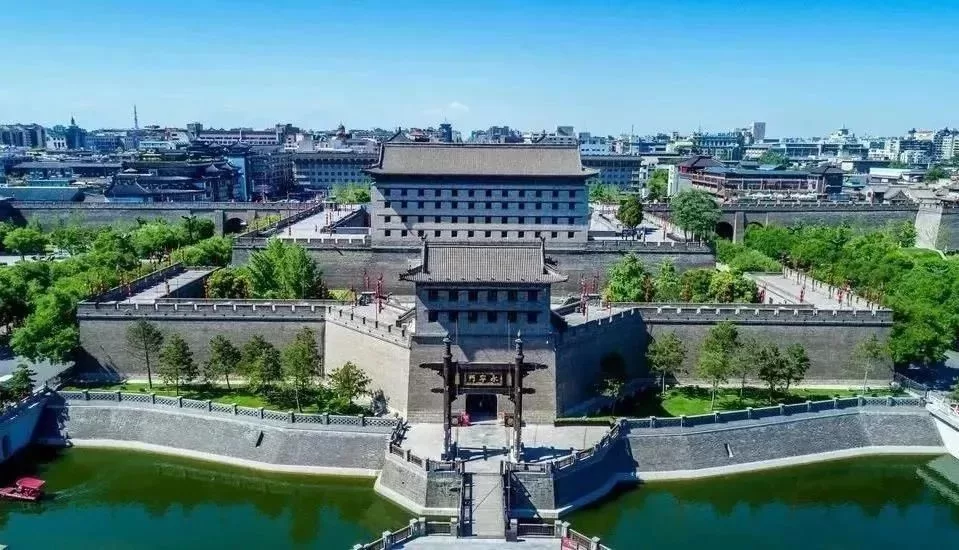
The South Gate, or Yongning Gate, is the most well-known and popular of the four gates, with its elegant and picturesque tower being one of the most photographed landmarks in Xi’an. The tower is a three-story wooden structure that is intricately decorated with beautiful carvings and paintings. South Gate is also the gateway to the city’s bustling downtown area and is pretty close to Shuyuanmen Street, a famous cultural and historical street, and the Stele Forest Musuem that houses over 3,000 stone tablets and sculptures.

The East Gate, also known as Changle Gate, is the smallest of the four gates, with a tower that is only two stories tall. However, it is still a beautiful and well-preserved structure that offers stunning views of the city from the top. The gate is also the starting point of the Xi’an City Wall Marathon, a popular annual event that attracts runners from all over the world, and is adjescent to Yongxingfang, a place to showcase the ancient city’s historical heritage.
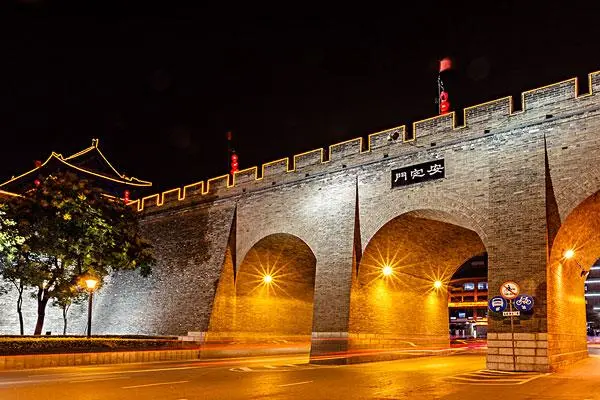
The West Gate, or Anding Gate, is the only gate that faces the direction of the Silk Road, a famous trade route that connected China with the Middle East and Europe. It is also the closest gate to the Xi’an railway station, making it a convenient point of entry for many visitors to the city. The gate is a popular spot for watching the sunset over the city, and there are many nearby parks and gardens where visitors can relax and enjoy the scenery.
Xi’an City Wall Biking
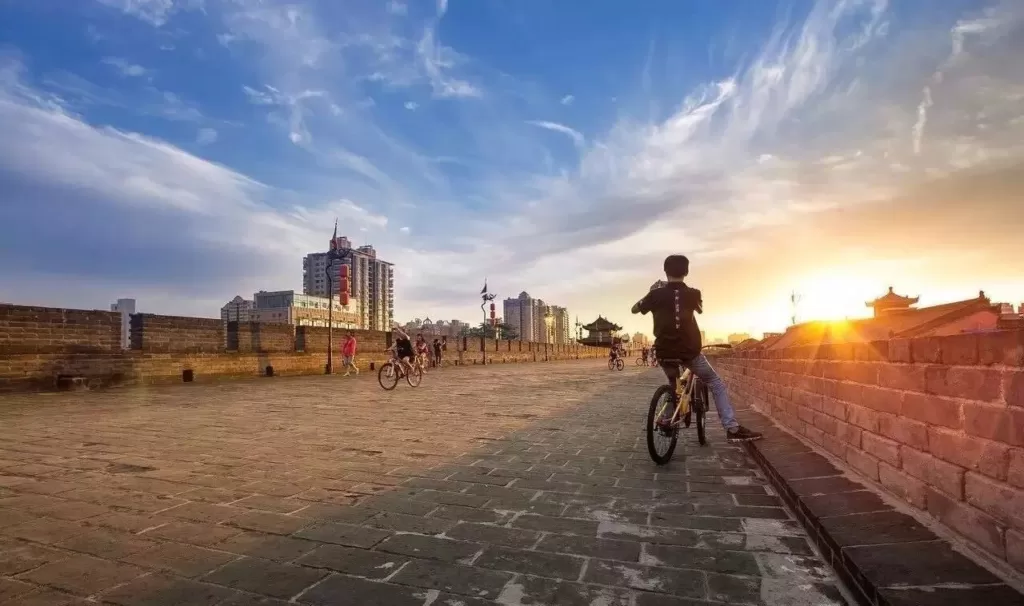
Bicycling on the Xi’an City Wall is a must-do activity for anyone visiting Xi’an. The wall offers a perfect path for cycling enthusiasts, with stunning views of the city from above. With a total length of 13.7 kilometers, visitors can easily ride the entire length of the wall, with stops at each of the four gates to admire their beauty and historical significance.
You can rent a bike at the South Gate (8.00 -22.00), West Gate, East Gate, North Gate, and Hanguang Gate (8.00 -19.00). The fare is 45 yuan for 3 hours, and you need to pay a deposit of 100 yuan. You can return the bike to any rental place instead of going back to where you rented it.
Watch Towers on the City Wall
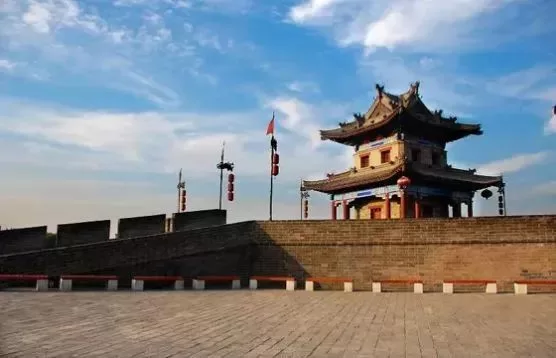
The watch towers on Xi’an city wall are an integral part of the ancient fortification system that once protected the city. Built during the Ming dynasty, these towers were strategically placed at intervals along the 14-kilometer wall and provided a vantage point for soldiers to keep watch for any potential threats.
There are a total of 98 watch towers on the wall, each with a unique architectural style and design. Some of the towers have sloping roofs, while others have flat roofs with battlements. Many of the towers are also adorned with beautiful carvings and inscriptions that depict various scenes from Chinese mythology and history.
Tunnels in Xi’an City Wall

The tunnels in Xi’an city wall are a fascinating feature that adds to the historical significance of the wall. These tunnels were built during the Ming dynasty to provide an efficient means of transportation and communication for soldiers stationed on the wall.
The tunnels are located at the base of the wall and run for several kilometers. They were used by soldiers to move quickly and discreetly from one section of the wall to another, as well as to store weapons, food, and supplies.
Vlog about Xi’an City Wall
Map and Recommended Routes
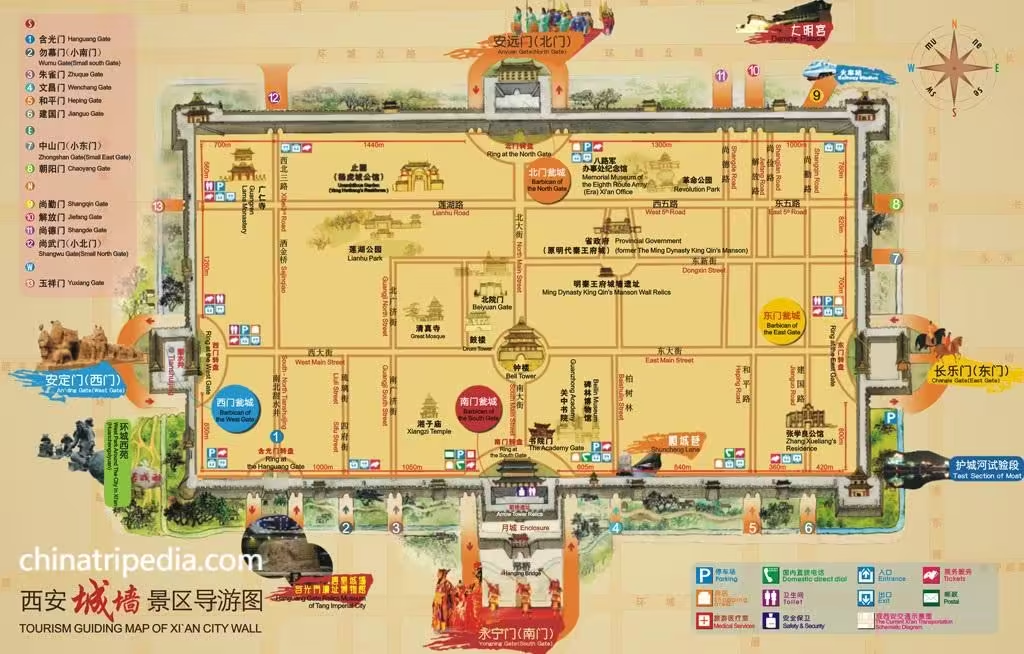
Xi’an City Wall is a historic fortification surrounding the old city of Xi’an, with eight gates providing access to the wall. These are: East Gate (Changle Gate), South Gate (Yongning Gate), West Gate (Anding Gate), North Gate (Anyuan Gate), Wenchang Gate, Hanguang Gate, Shangde Gate, and Zhongshan Gate (near Yongxingfang).
Recommended Routes:
South Gate (Yongning Gate) to Zhongshan Gate:
- Route Description: Start at the South Gate (Yongning Gate), walk eastward, passing by Wenchang Gate, Jianguo Gate, the Southeast Corner Tower, Changle Gate, and end at Zhongshan Gate.
- Why Choose This Route: This is the classic walking route for experiencing the wall. Yongning Gate is the most well-preserved of the four main gates, offering intact structures including the gate tower, arrow towers, and the city wall itself. The entire journey takes about 40 minutes. You can explore Yongxingfang for local snacks once you reach Zhongshan Gate. This route can also be done in reverse: start at Zhongshan Gate and visit Yongxingfang after walking along the wall.
East Gate (Changle Gate) to South Gate (Yongning Gate):
- Route Description: Begin at the East Gate (Changle Gate) and head west, passing by the Southeast Corner Tower, Jianguo Gate, Wenchang Gate, and finally the South Gate (Yongning Gate).
- Why Choose This Route: This route is slightly more relaxed. After descending the wall, you can visit Xi’an’s SKP mall to experience modern urban life or explore nearby areas like “Liuyuan” and “Songyuan” for shopping and dining.
Photography Spots near Yongning Gate
Yongning Gate Central Axis
- 📍 100 meters to the right from the entrance of the city wall.
- Description: Capture the central axis of Yongning Gate, showcasing the grandeur and symmetry of the ancient fortifications.
Yongning Post Ancient Building Complex
- 📍 50 meters to the left from the city wall entrance.
- Description: This area features a collection of historic buildings that add a classic architectural touch to your photos.
Yongning Gate Enemy Tower
- 📍 100 meters to the right and slightly backward after ascending the city tower.
- Description: Photograph the defensive structure of the enemy tower, highlighting its historical military significance.
Yongning Gate Red Gate
- 📍 50 meters in front of the ticket check area at Yongning Gate.
- Description: A striking red gate that provides a vibrant contrast against the surrounding architecture.
Yongning Gate Gatehouse
- 📍 50 meters straight ahead from the ticket check area.
- Description: Capture the historic gatehouse that stands as a testament to the grandeur of ancient city defenses.
Yongning Gate Archway
- 📍 50 meters straight ahead from the ticket check area.
- Description: An elegant archway offering a classic framing element for your photographs.
Yongning Gate Pavilion
- 📍 Directly opposite the A1 exit of Yongning Gate Metro Station.
- Description: The pavilion provides a scenic backdrop with its distinctive architectural style.
City Wall Brick Details
- 📍 Walk past the ticket check area on the left side.
- Description: Close-up shots of the city wall bricks reveal the intricate details and historical texture of the ancient fortifications.
Popular Restaurants near Yongning Gate
Qin Jiao Spicy Oil Noodles (Biangbiang Noodles) – Zhongmao Store (秦椒香油泼面 – 中贸店)
- Description: Known for its chewy noodles and fragrant spicy oil, this restaurant offers a flavorful experience. Add a bit of vinegar, mix, and enjoy the rich taste. The spacious venue and friendly service enhance the dining experience.
Xue Changli Rice Noodles – South Gate Street Store (薛昌利大米面皮 – 南关正街店)
- Description: Considered the best quality among Xue Changli’s locations in Xi’an, this spot serves soft, chewy rice noodles with aromatic red oil that’s not overly spicy. Fresh bean sprouts and celery add to the deliciousness.
Chao Xiang Le Chopped Chili Noodles – Heshenghui Store (超享乐剁椒面 – 合生汇店)
- Description: Enjoy the fragrant chopped chili with adjustable spiciness. The unique flavor is savory without being too spicy, making it a great choice for chili lovers.
Lion City Claypot Rice – Heshenghui Store (狮城煲仔屋 – 合生汇店)
- Description: A branch of the well-established restaurant originally located in Juhua Garden. Specialties include marinated barbecue pork and Hong Kong-style sausages. The dried tangerine peel red bean paste is also recommended. Ideal for claypot rice enthusiasts.
Fang Ha Sweet Fermented Rice Tea Creator – Heshenghui Store (放哈·甜醅子奶茶创造者 – 合生汇店)
- Description: Originating from Lanzhou, this store brings its signature sweet fermented rice tea to Xi’an. The tea is rich and sweet (with customizable sweetness levels), and the green tea is refreshing. Perfect for a thirst-quencher after climbing the city wall.
History of Xi’an City Wall
Construction During the Sui Dynasty
The Xi’an City Wall’s history dates back to the Sui Dynasty (581-618 AD), a period marked by significant urban development. After Emperor Wen of the Sui Dynasty, Yang Jian, established his regime, he initially resided in the Han Chang’an City. However, Han Chang’an City was dilapidated, cramped, and plagued by water pollution. Consequently, a decision was made to construct a new city on the southern slope of Longshou Plain to the southeast.
In 582 AD, the construction of the Daxing Palace marked the beginning of the new city’s development. Under the supervision of Yu Wenkai, the palace and imperial city were completed in about nine months. By 583 AD, the Sui Empire relocated to the new capital, named Daxing, after the emperor’s early title of Duke of Daxing. The palace was called Daxing Palace.
In 613 AD, Emperor Yang of the Sui Dynasty mobilized over 100,000 people to construct an outer city beyond the palace and imperial city, finalizing the city’s overall layout. This structure was inherited and continued by the Tang Dynasty. At its height, the city of Daxing, known later as Chang’an during the Tang Dynasty, measured 9,721 meters in width from east to west and 8,652 meters in length from north to south, with a total perimeter of 36.74 kilometers and an area of 84 square kilometers, making it one of the largest ancient cities in China.
Reduction and Reconstruction During the Tang Dynasty
In 618 AD, Li Yuan established the Tang Dynasty and inherited the Sui capital. The city of Daxing was renamed Chang’an, and Daxing Palace was renamed Taiji Palace. Towards the end of the Tang Dynasty, Chang’an suffered significant damage due to warfare. The governor of Youguo Army, Han Jian, undertook a reconstruction of the city.
Han Jian abandoned the outer city and palace walls of the original Chang’an City, retaining only the imperial city, which was then reinforced and surrounded by high city walls. The original imperial city’s southern wall was used as the northern wall of the new city, connecting with the east and west walls of the imperial city. This made the imperial city a robust fortress with high walls on all sides, and the original gates were sealed off to enhance defense. The reconstructed city, known as “New City,” had a perimeter of 9.2 kilometers, a quarter of the original Chang’an City’s perimeter. Inside the city, administrative districts were established, and smaller cities were built outside the eastern and western walls for administrative purposes.
Over subsequent dynasties—Five Dynasties, Song, Yuan—the name and structure of Chang’an City changed, but the scale of the city walls remained largely unchanged, reflecting the gradual decline of the ancient capital.
Reconstruction During the Yuan Dynasty
During the Yuan Dynasty, the city of Fengyuan Road (previously known as Anxi Prefecture City) retained a similar layout. In 1273 AD, construction began on the Anxi Palace to the northeast of the city, near the Hu River. This area, approximately 0.3 square kilometers in size, was praised by Italian traveler Marco Polo for its impressive walls and luxurious palace surrounded by rivers and lakes. Despite the changes over the Yuan, Song, and Jin Dynasties, the scale of the “New City” remained largely consistent.
Renovation During the Ming Dynasty
Before the Ming Dynasty was established, Zhu Yuanzhang, after conquering Huizhou, was advised by a recluse named Zhu Sheng to “build high walls, store grain widely, and delay proclaiming oneself king.” Zhu Yuanzhang adopted these suggestions. In 1369 AD, General Xu Da led troops into Shanxi and captured Fengyuan City. Shortly after, the Ming Dynasty renamed Fengyuan Road to Xi’an Fu, marking the beginning of Xi’an’s modern name.
After the unification of China, Zhu Yuanzhang ordered the construction of city walls across the country. In 1374 AD, construction of the Xi’an City Wall began, completing in 1378 AD. Zhu Yuanzhang valued Xi’an highly, believing it to be the most defensible city in China. The Ming Dynasty rebuilt Xi’an City on the foundation of the Tang Dynasty’s imperial city. The Ming city walls used the original Tang walls for the west and south sections, while new construction was added to the east and north.
The city walls of Xi’an during the Ming Dynasty encircled the Qinwang Mansion, creating a dual-layered city structure. The inner and outer city walls were built to protect the Qinwang Mansion, with the outer city wall surrounding the entire complex. In 1568 AD, during the reign of Emperor Muzong, the walls were rebuilt with blue bricks, transforming the earth walls into brick walls.
In 1636 AD, during the reign of Emperor Shunzhi, repairs included rebuilding the destroyed gate towers and dredging the moat. The wall had four gates: Chang Le Gate (East), An Ding Gate (West), Yong Ning Gate (South), and An Yuan Gate (North), each with three tiers of defensive structures.
Preservation and Repair During the Qing Dynasty
During the Qing Dynasty, Xi’an was a significant regional center and military stronghold. The city walls underwent several repairs and reinforcements. In 1656 AD, Governor Chen Jixin repaired the walls and rebuilt the destroyed gate towers. Further maintenance continued throughout the Qing period, including dredging the moats and repairing sections of the wall.
Notably, between 1781 and 1786 AD, the Qing Dynasty undertook a major renovation of the Xi’an City Wall, led by officials including Governor Bi Yuan. This extensive repair project, noted for its scale and cost, ensured the preservation of the wall’s substantial size and structure, which spanned approximately 14 kilometers in perimeter and covered an area of about 11.6 square kilometers.
In the late Qing Dynasty, during the turmoil of the late 19th century, additional repairs and maintenance were carried out, including dredging the moats and reinforcing the walls.
The 20th Century and Modern Era
In 1911 AD, during the Xinhai Revolution, the Qing forces retreated into the city, and the north gate, An Yuan Gate, was destroyed by the advancing New Army. The city faced further damage during subsequent conflicts, including the intense “Two Tigers Defending Chang’an” battle in 1926, where the walls’ defensive capabilities were put to the test against a much larger attacking force.
Despite the frequent warfare and economic decline during the Republic of China era, efforts were made to preserve and repair the city walls. Local authorities implemented protective measures and conducted minor repairs to maintain the wall’s integrity.
Useful Tips Summarzied from Rivews
Festivals: The south gate of the city wall will be decorated with lights and lanterns during festivals, which make it even more gorgeous. But this also means the crowd. You had better weigh the pros and cons when visiting the wall during these times.
Bike for couples: Apart from the normal bike, there are also bikes for couples on the wall. The price is 90 yuan for 3 hours.
Entrances: Although you can ascend to the wall from 8 entrances, the south gate has the most well-established facilities and wonderful views. So, I highly recommend you choose this entrance.
Extra charge for hiring a bike: If you do not return the bike in 3 hours, they will charge you an extra fare, which is 5 yuan every 10 minutes for the single bike and 10 yuan every 10 minutes for the couple. But normally, it only takes you two hours to finish the tour.





